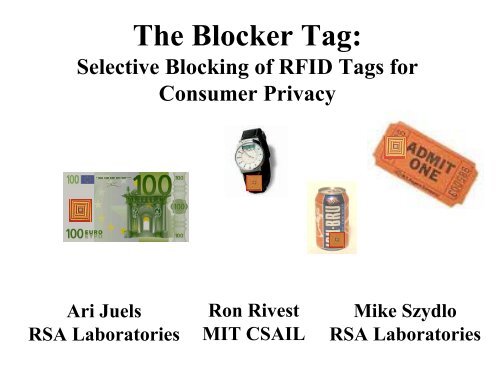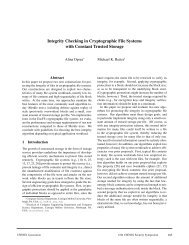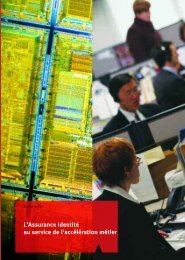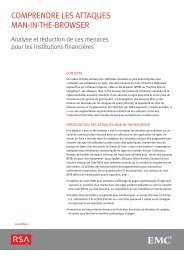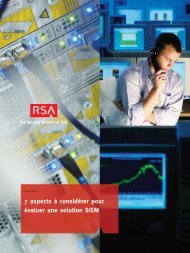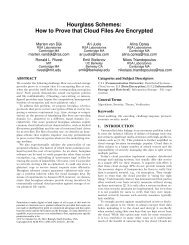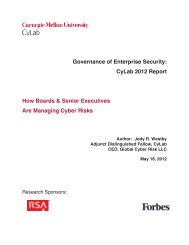The Blocker Tag: - RSA
The Blocker Tag: - RSA
The Blocker Tag: - RSA
You also want an ePaper? Increase the reach of your titles
YUMPU automatically turns print PDFs into web optimized ePapers that Google loves.
<strong>The</strong> <strong>Blocker</strong> <strong>Tag</strong>:<br />
Selective Blocking of RFID <strong>Tag</strong>s for<br />
Consumer Privacy<br />
Ari Juels<br />
<strong>RSA</strong> Laboratories<br />
Ron Rivest<br />
MIT CSAIL<br />
Mike Szydlo<br />
<strong>RSA</strong> Laboratories
What is a Radio-Frequency<br />
Identification (RFID) tag?<br />
• In terms of appearance…<br />
Chip (IC)<br />
Antenna
What is an RFID tag?<br />
• You may own a few RFID tags…<br />
– Contactless physical-access cards<br />
– Automated toll payment<br />
• At present, an RFID tag simply calls out its<br />
(unique) name or static data over a short distance<br />
“Plastic #3”<br />
“5F8KJ3”<br />
“74AB8”
<strong>The</strong> capabilities of basic<br />
RFID tags<br />
• No power<br />
– Receives power from reader<br />
– Range a few meters<br />
• Little memory<br />
– Static 64-to-128-bit identifier in current ultra-cheap<br />
generation (five cents / unit)<br />
– Hundreds of bits soon<br />
• Little computational power<br />
– A few thousand gates<br />
– No cryptographic functions available<br />
– Static keys for read/write permission
<strong>The</strong> grand vision:<br />
RFID as next-generation barcode<br />
Barcode RFID tag<br />
Line-of-sight Radio contact<br />
Specifies object type Uniquely specifies object<br />
Fast, automated<br />
scanning<br />
Provides pointer<br />
to database entry<br />
for every object
Commercial applications<br />
• Smoother inventory tracking<br />
– Military supply logistics<br />
• Gulf War I: Placement of double orders to ensure arrival<br />
• Gulf War II: RFID renders supply chain much more reliable<br />
• Product recalls<br />
• Anti-counterfeiting<br />
• Maintaining shelf stocks in retail environments<br />
– Gillette Mach3 razor blades<br />
• Parenting logistics<br />
– Water park uses RFID bracelets to track children
<strong>The</strong>re is an impending explosion<br />
in RFID-tag use<br />
• Wal-Mart requiring top 100 suppliers to deploy RFID at pallet<br />
level by 2005<br />
• Gillette announced order of 500,000,000 RFID tags<br />
• Auto-ID Center at MIT<br />
– Wal-Mart, Gillette, Procter & Gamble, etc.<br />
– Spearheading EPC (electronic product code) data standard for tags<br />
– Developing cheap manufacturing techniques<br />
– Handing over standards to Uniform Code Council<br />
• Estimated costs<br />
• 2005: $0.05 per tag; $100 per reader<br />
• 2008: $0.01 per tag; several dollars per reader (?)
<strong>The</strong> Consumer-Privacy Problem
RFID tags will be everywhere…<br />
30 items<br />
of lingerie<br />
Replacement hip<br />
medical part #459382<br />
Wig<br />
model #4456<br />
(cheap polyester)<br />
Das Kapital and<br />
Communist-party<br />
handbook<br />
500 Euros<br />
in wallet<br />
Serial numbers:<br />
597387,389473…
Simple approaches to consumer privacy<br />
Method 1:<br />
Place RFID-tags<br />
in protective mesh<br />
or foil<br />
Problem:<br />
makes locomotion<br />
difficult… perhaps<br />
useful for wallets
Simple approaches to consumer privacy<br />
Method 2:<br />
“Kill” RFID tags<br />
Problem:<br />
RFID tags are<br />
much too useful…
Some consumer applications<br />
• House pets<br />
today<br />
• Prada, Soho NYC<br />
– Personalization / accessorization<br />
• Building access (HID)<br />
• ExxonMobil Speedpass
Consumer applications tomorrow<br />
• “Smart” appliances<br />
– Refrigerators that automatically create shopping lists<br />
– Closets that tell you what clothes you have available, and search the<br />
Web for advice on current styles, etc.<br />
– Ovens that know how to cook pre-packaged food<br />
• “Smart” products<br />
– Clothing, appliances, CDs, etc. tagged for store returns<br />
• “Smart” paper<br />
– Airline tickets that indicate your location in the airport<br />
– Library books<br />
– Business cards<br />
• Recycling<br />
– Plastics that sort themselves
Early examples of consumer<br />
backlash<br />
• 42% of Google results on “RFID” include word<br />
“privacy”<br />
• CASPIAN (Consumers Against Supermarket Privacy Invasion and Numbering)<br />
– Diatribes on RFID at:<br />
• NoCards.org<br />
• BoycottGillette.com<br />
• BoycottBenetton.com<br />
– National news coverage: NY Times, Time, etc.<br />
• Wal-Mart “smart-shelf project” cancelled<br />
• Benetton RFID plans withdrawn
<strong>The</strong> two messages of<br />
this talk<br />
1. Deployed naïvely, embedding of<br />
RFID tags in consumer items<br />
presents a serious danger to privacy.<br />
2. <strong>The</strong> danger can be mitigated: It is<br />
possible to strike a balance between<br />
privacy and convenience.
<strong>The</strong> “<strong>Blocker</strong>” <strong>Tag</strong>
“<strong>Blocker</strong>” <strong>Tag</strong><br />
<strong>Blocker</strong> simulates<br />
all (billions of)<br />
possible tag serial<br />
numbers!!<br />
1,2,3, …, 2023 pairs<br />
of sneakers and…<br />
(reading fails)…
“Tree-walking” anti-collision<br />
protocol for RFID tags<br />
0 1<br />
?<br />
00 01 10 11<br />
000 001 010 011 100 101 110 111
In a nutshell<br />
• “Tree-walking” protocol for identifying tags<br />
recursively asks question:<br />
– “What is your next bit?”<br />
• <strong>Blocker</strong> tag always says both ‘0’ and ‘1’!<br />
– Makes it seem like all possible tags are present<br />
– Reader cannot figure out which tags are actually<br />
present<br />
– Number of possible tags is huge (at least a billion<br />
billion), so reader stalls
Two bottles<br />
of Merlot<br />
#458790<br />
<strong>Blocker</strong> tag system should protect privacy but still<br />
avoid blocking unpurchased items
Consumer privacy +<br />
commercial security<br />
• <strong>Blocker</strong> tag can be selective:<br />
– Privacy zones: Only block certain ranges of RFID-tag<br />
serial numbers<br />
– Zone mobility: Allow shops to move items into privacy<br />
zone upon purchase<br />
• Example:<br />
– <strong>Blocker</strong> blocks all identifiers with leading ‘1’ bit<br />
– Items in supermarket carry leading ‘0’ bit<br />
– On checkout, leading bit is flipped from ‘0’ to ‘1’<br />
• PIN required, as for “kill” operation
Blocking with privacy zones<br />
0 1<br />
00 01 10 11<br />
000 001 010 011 100 101 110 111<br />
Transfer to privacy zone<br />
on purchase of item<br />
Privacy zone
Polite blocking<br />
• We want reader to scan privacy zone when blocker<br />
is not present<br />
– Aim of blocker is to keep functionality active – when<br />
desired by owner<br />
• But if reader attempts to scan when blocker is<br />
present, it will stall!<br />
• Polite blocking: <strong>Blocker</strong> informs reader of its<br />
presence<br />
Your humble servant<br />
requests that you not<br />
scan the privacy zone
More about blocker tags<br />
• <strong>Blocker</strong> tag can be cheap<br />
– Essentially just a “yes” tag and “no” tag with a<br />
little extra logic<br />
– Can be embedded in shopping bags, etc.<br />
• With multiple privacy zones, sophisticated,<br />
e.g., graduated policies are possible<br />
• Standards integration would be quite helpful<br />
– AutoID Center (UCC) may support this
Final remarks<br />
• Spectrum of RFID devices<br />
– $0.05 vs. $1.00<br />
• Privacy is not just a consumer issue – it’s also a corporate issue<br />
• Privacy is just one of many RFID-related security issues!<br />
– As “Extended Internet”, RFID represents extension of traditional security<br />
perimeter<br />
• Legislation and technology most effective in concert<br />
• “Proponents [of RFID] envision a pervasive global network of millions of receivers<br />
along the entire supply chain -- in airports, seaports, highways, distribution centers,<br />
warehouses, retail stores, and in the home. This would allow for seamless,<br />
continuous identification and tracking of physical items as they move from one place<br />
to another, enabling companies to determine the whereabouts of all their products at<br />
all times.”<br />
• Contrast a physical reality of RFID tags:<br />
– Manufacturers struggling with reliability, e.g., UHF tags hard to read near<br />
human body!
More about RFID work<br />
• See ari-juels.com for “blocker” info<br />
• Also see:<br />
– MIT RFID Privacy Workshop, 15 November 2003<br />
• www.rfidprivacy.org<br />
– AutoID center: www.autoidcenter.org<br />
– Master’s thesis of Steve Weis<br />
– “Bill of Rights” of Simson Garfinkel<br />
– Electronic Privacy Information Center Web site<br />
(URL: www.epic.org/privacy/rfid/)<br />
– CASPIAN (yellow journalism) (URL: www.nocards.org)


